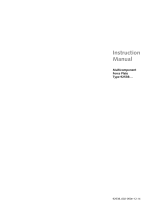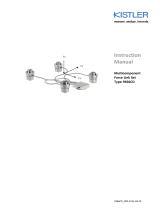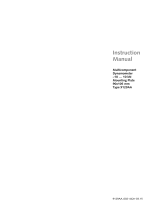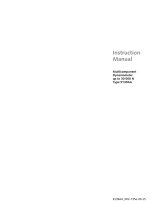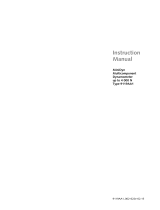Page is loading ...

Instruction
Manual
Multicomponent Force
Plate for Biomechanics
Type 9287C…
ä
9287C_002-462e-03.11

Instruction
Manual
Multicomponent Force
Plate for Biomechanics
Type 9287C…
ä
9287C_002-462e-03.11


Foreword
9287C_002-462e-03.11 Page 1
Foreword
Thank you for choosing a Kistler quality product character-
ized by technical innovation, precision and long life.
Information in this document is subject to change without
notice. Kistler reserves the right to change or improve its
products and make changes in the content without obliga-
tion to notify any person or organization of such changes
or improvements.
©2008 … 2011 Kistler Group. All rights reserved. Except as
expressly provided herein, no part of this manual may be
reproduced for any purpose without the express prior writ-
ten consent of Kistler Group.
Kistler Group
Eulachstrasse 22
8408 Winterthur
Switzerland
Tel. +41 52 224 11 11
Fax +41 52 224 14 14
www.kistler.com

Multicomponent Force Plate for Biomechanics Type 9287C…
Content
1. Introduction ................................................................................................................................... 4
2. Important Information.................................................................................................................... 5
2.1 For your Safety..................................................................................................................... 5
2.2 ä-Conformity.....................................................................................................................6
2.3 How to Treat the Instrument................................................................................................ 6
2.3.1 With External Amplifier (Type 9287C).................................................................................. 6
2.4 Hints for Using the Instruction Manual................................................................................. 7
2.5 What Happens After Modifications? .................................................................................... 7
2.6 Disposal Instructions for Electrical and Electronic Equipment ................................................ 7
3. General Description of the Instrument ...........................................................................................8
3.1 What does a Multicomponent Force Plate Do? .................................................................... 8
3.2 Two Different Versions......................................................................................................... 9
3.3 Application Examples ........................................................................................................... 9
3.4 Functional Principle .............................................................................................................. 9
3.5 Design of the Force Plate ................................................................................................... 11
4. Assembly, Installation and Putting Into Operation...................................................................... 12
4.1 Important Remarks............................................................................................................. 12
4.2 Basic Circuitry and Cabling of the Measuring System ......................................................... 13
4.3 Connections with External Amplifier (Type 9287C) ............................................................ 14
4.3.1 Output Connector of Force Plate Type 9287C (with External Amplifier)............................ 15
4.4 Connections with Built-in Amplifier (Type 9287CA) ........................................................... 16
4.4.1 Output Connector of Force Plate Type 9287CA (with Built-in Amplifier) ........................... 17
4.4.2 Cable Type 1759................................................................................................................ 18
4.4.3 Digital Control 19
5. Operation..................................................................................................................................... 20
5.1 Range Selection.................................................................................................................. 20
5.2 Operate/Reset ...................................................................................................................20
5.2.1 Balance (Posturography) .................................................................................................... 21
5.3 Time Constant.................................................................................................................... 21
5.4 Effective Frequency Range ................................................................................................. 21
5.5 Temperature Influences...................................................................................................... 22
5.6 Polarity of the Measuring Signal......................................................................................... 22
5.6.1 x and y Directions. .............................................................................................................22
5.6.2 z Direction .............................................................................................................. 22
5.7 Surface Pressure ................................................................................................................. 23
Page 2 9287C_002-462e-03.11

Content
9287C_002-462e-03.11 Page 3
6. Maintenance.................................................................................................................................24
6.1 Recalibration of the Instrument...........................................................................................24
6.2 Weekly Function Check ......................................................................................................24
6.2.1 Drift Check ...............................................................................................................24
6.2.2 Check Gap Around Force Plate ...........................................................................................24
6.2.3 System Check ...............................................................................................................25
6.2.4 Setup Parameters ...............................................................................................................25
6.3 Regular Calibration of the Charge Amplifier........................................................................25
6.4 Calibration of the Force Plate..............................................................................................26
6.5 Regular Checks ...................................................................................................................26
6.5.1 With External Amplifier (Type 9287C) ................................................................................26
6.6 Cleaning and Sterilization....................................................................................................27
7. Trouble Shooting ..........................................................................................................................28
7.1 Defective Force Plate ..........................................................................................................28
8. Technical Data ..............................................................................................................................29
8.1 Dimensions .........................................................................................................................29
8.2 Technical Data for Type 9287C...........................................................................................30
8.2.1 Mechanical and Environment..............................................................................................31
8.2.2 Electrical ...............................................................................................................31
8.3 Technical Data for Type 9287CA ........................................................................................32
8.3.1 General ...............................................................................................................32
8.3.2 Mechanical and Environment..............................................................................................33
8.3.3 Electrical ...............................................................................................................33
8.3.4 Built-In 8 Channel Charge Amplifier....................................................................................34
8.4 Center of Pressure COP Accuracy .......................................................................................35
8.4.1 Error ax ...............................................................................................................35
8.4.2 Error ay ...............................................................................................................35
8.4.3 COP Correction Algorithm for Force Plates.........................................................................36
8.5 Frequency Response ...........................................................................................................37
9. Glossary........................................................................................................................................38
9.1 Coordinate System..............................................................................................................38
9.1.1 Kistler Coordinate System ...................................................................................................38
9.1.2 ISB Coordinate System........................................................................................................39
9.2 Parameters Calculation........................................................................................................39
10. Warranty.......................................................................................................................................40
11. Declaration of Conformity ............................................................................................................41
Total pages 42

Multicomponent Force Plate for Biomechanics Type 9287C…
1. Introduction
Please take the time to thoroughly read this instruction
manual. It will help you with the installation, maintenance,
and use of this product.
To the extent permitted by law Kistler does not accept any
liability if this instruction manual is not followed or prod-
ucts other than those listed under Accessories are used.
Kistler offers a wide range of products for use in measuring
technology:
Piezoelectric sensors for measuring force, torque, strain,
pressure, acceleration, shock, vibration and acoustic-
emission
Strain gage sensor systems for measuring force and
torque
Piezoresistive pressure sensors and transmitters
Signal conditioners, indicators and calibrators
Electronic control and monitoring systems as well as
software for specific measurement applications
Data transmission modules (telemetry)
Kistler also develops and produces measuring solutions for
the application fields engines, vehicles, manufacturing,
plastics and biomechanics sectors.
Our product and application brochures will provide you
with an overview of our product range. Detailed data
sheets are available for almost all products.
If you need additional help beyond what can be found ei-
ther on-line or in this manual, please contact Kistler's ex-
tensive support organizationn.
Page 4 9287C_002-462e-03.11

Important Information
9287C_002-462e-03.11 Page 5
2. Important Information
Please keep to the following rules without fail. This will en-
sure your personal safety when working, and assure long,
trouble-free performance by the instrument.
2.1 For your Safety
This instrument has been tested thoroughly and it left
the works in a perfectly safe condition. To maintain this
condition and assure safe operation, the user must ob-
serve the directives and warnings contained in these in-
structions
The force plate must be installed, operated and main-
tained only by persons who are familiar with it and
adequately qualified for their particular tasks
When it must be assumed that safe operation is no
longer possible, the instrument must be taken out of
operation and secured against unintentional use
It must be assumed that safe operation is no longer
possible if:
the instrument is visibly damaged
it no longer functions
it has been in lengthy storage under adverse con-
ditions
it has received rough treatment during transport
According to safety requirements the following has to be
observed:
The force plate should be mounted as written in chap-
ter 4.
The force plate has to be connected to earth using the
Potential Equalization Conductor provided in the scope
of delivery to meet the ä-standards regarding Earth
Leakage Current.
The data acquisition computer and persons who are in
direct contact with it have to remain in a distance of
1,5 m from the patient at all times for the same reason.

Multicomponent Force Plate for Biomechanics Type 9287C…
2.2 ä-Conformity
The Force Plate Type 9287C… is conforming to ä direc-
tives according to the Declaration of Conformity enclosed
with this instruction manual.
2.3 How to Treat the Instrument
The force plate may be used only under the specified
environmental and operating conditions
Protect the signal output against dirt and do not touch
it with your fingers. When the connection is not being
used, cover it with the cap provided
When the force plate is not in use, protect it by keeping
it in the packing case supplied
When performing long-time measurements, make sure
that the temperature of the force plate remains as con-
stant as possible
2.3.1 With External Amplifier (Type 9287C)
The insulation resistance is crucially important with pie-
zoelectric measurements. It must be around 1014 Ω (but
at least 1013 Ω)
To obtain this resistance, all plug and socket connec-
tions must be kept meticulously clean and dry
The insulation resistance can be measured with the in-
sulation tester Type 5493
The connecting cable from force plate to charge ampli-
fier is highly insulating. Use only the proper cable
Do not remove the connecting cable from the force
plate
Page 6 9287C_002-462e-03.11

Important Information
2.4 Hints for Using the Instruction Manual
We recommend reading the entire instruction manual as a
matter of principle. If you're in a hurry, however, and
you've already gathered experience with Kistler force
plates, you can confine your reading to the information
that you really need.
We have endeavoured to arrange these instructions so that
you can find the information you need without difficulty.
Please keep these instruction manual in a safe place where
they can be consulted any time.
If the instructions get lost, just turn to your Kistler distribu-
tor and they will be replaced without delay.
All information and directives in these instructions may be
modified at any time without prior notification.
2.5 What Happens After Modifications?
Modifications to instruments result in alterations of the in-
struction manuals as a rule. In such cases, enquire at your
Kistler distributor about the possibilities of updating your
documentation.
2.6 Disposal Instructions for Electrical and Electronic Equipment
Do not discard old electronic instruments in municipal
trash. For disposal at end of life, please return this prod-
uct to an authorized local electronic waste disposal ser-
vice or contact the nearest Kistler Instrument sales office
for return instructions.
9287C_002-462e-03.11 Page 7

Multicomponent Force Plate for Biomechanics Type 9287C…
3. General Description of the Instrument
3.1 What does a Multicomponent Force Plate Do?
The multicomponent force plate provides dynamic and
quasistatic measurement of the 3 orthogonal components
of a force (Fx, Fy, Fz) acting from any direction onto
the top plate.
With the aid of optional evaluation devices (e.g. software
system BioWare) the following quantities can also be
measured:
The moments Mx, My and Mz
The coordinates ax and ay of the point of application of
force on the force plate surface COP = Center of Pres-
sure
The torque Tz (free moment) around an axis normal to
the force plate surface
Center of mass displacement and acceleration, physical
power and work, coefficient of friction
The multicomponent force plate distinguishes itself
especially by the following features:
Large surface, resulting in a high probability to hit it in
sports
Wide measuring and frequency range
Light weight
High overload capacity
Corrosion resistant design, protected against splashing
water
Fig. 1: Multicomponent force plate for biomechanics Type
9287C…
Page 8 9287C_002-462e-03.11

General Description of the Instrument
3.2 Two Different Versions
The force plate 9287C... is available in two versions:
Type 9287C with external 8 channel amplifier
(e.g. Type 9865…)
Type 9287CA with built-in charge amplifier
3.3 Application Examples
The force plate is particularly suitable to measure fast
actions and impact in sports but it can also be used for
a wide range of other applications
Biomechanical investigations, e.g. recording the forces
exerted by the human foot when standing, walking or
running (gait analysis)
Orthopaedic examinations
Determining progress in rehabilitation, e.g. with pros-
thesis, after fractures etc.
Analysis of high dynamic sports activities to optimize
training and for competition analysis (e.g. starting and
takeoff behaviour, performance measurement etc.)
Coefficients of friction can be determined dynamically
and statically with the BioWare software system
3.4 Functional Principle
The force to be measured is introduced via a top plate and
distributed between four 3-component force sensors ar-
ranged between mounting base and top plate. Each of the
sensors has three pairs of quartz plates, one sensitive to
pressure in the z-direction and the other two to shear in
the x- and y-directions respectively. The measurement is
virtually without displacement. In these four force sensors
the force introduced is resolved into three components.
Fig. 2: 3-component force sensor
9287C_002-462e-03.11 Page 9

Multicomponent Force Plate for Biomechanics Type 9287C…
The electrical charges yielded by the force plate are strictly
proportional to the measured quantities. They are converted
by charge amplifiers into analog voltages and can then be
processed in any way.
Negative charges give positive voltages at the output of the
charge amplifier, and vice versa.
Out of the 12 output signals of the 4 sensors, 2 each of the
shear forces which have the same line of action can be par-
alleled (e.g. Fx1 and Fx2 to obtain Fx1+2, etc.). Therefore, only
8 signals are needed for further processing.
Fig. 3: Output signals of the force plate
Page 10 9287C_002-462e-03.11

General Description of the Instrument
3.5 Design of the Force Plate
The force plate comprises a top plate of sandwich light-
weight construction under which the four 3-compo-nent
force sensors are mounted under high prestress.
This prestress is a prerequisite for transmissing shear forces
by friction.
Fig. 4: Cross section through the force plate
1 3-component force sensor
2 Prestressing elements (hollow screw)
3 Cabling
4 Top plate of sandwich lightweight construction
5 Top cover with 0-ring
6 Fastening screw M12x25
7 Mounting frame Type 9427
The four prestressing elements are at the same time the
feet upon which the force plate rests and with which it is
screwed down onto the mounting frame.
The force plate is corrosion-resistant and proof against
splashing water (degree of protection IP65).
9287C_002-462e-03.11 Page 11

Multicomponent Force Plate for Biomechanics Type 9287C…
4. Assembly, Installation and Putting Into Operation
4.1 Important Remarks
The multicomponent force plate Type 9287C... is a preci-
sion instrument, however its inherent accuracy can only be
exploited and retained if it is treated carefully. The follow-
ing points should be observed:
Never drop the force plate or expose it to heavy im-
pacts! The maximum force of a shock of this kind could
exceed the measuring range of the instrument and
cause damage
For safety reasons the force plate has to be grounded
using a separate ground wire connected to the M4
thread near the platform connector
Observe that the surface pressure is limited to max.
5 N/mm2. (Details see technical data)
The force plate should be installed only by persons suf-
ficiently qualified for this job
For the force plate 9287C... the mounting frame 9427
is available for correct mounting on a concrete base
Basically the mounting frame is grouted onto the con-
crete base using castable grout. Then the force plate is
screwed onto the mounting frame, with a gap separat-
ing the top plate from the surrounding structure
Please refer to the instruction manual 002-034 "Force
Plate Installation and Maintenance" for detailed proce-
dures and information.
For nonobservance of the mounting instructions Kistler
will decline all responsibility.
Page 12 9287C_002-462e-03.11

Assembly, Installation and Putting Into Operation
4.2 Basic Circuitry and Cabling of the Measuring System
The electric charges (in pC) yielded by the force plate are
converted by charge amplifiers into proportional voltages,
which in turn can be displayed, recorded or further proc-
essed using appropriate equipment.
The following rules should be observed when cabling the
measuring rig:
Between force plate and charge amplifier the special
cables supplied by Kistler must be used
Ordinary cables may be used to link the charge amplifi-
ers with the display or evaluation instruments
Make sure that all work with electrical connections is
done carefully and with cleanliness. Remove the protec-
tive caps from the connections only immediately before
connecting a cable
According to safety requirements the following has to be
observed:
The force plate has to be connected to earth using the
Potential Equalization Conductor provided in the scope
of delivery to meet the ä-standards regarding Earth
Leakage Current.
The data acquisition computer and persons who are in
direct contact with it have to remain in a distance of
1,5 m from the patient at all times for the same reason.
9287C_002-462e-03.11 Page 13

Multicomponent Force Plate for Biomechanics Type 9287C…
4.3 Connections with External Amplifier (Type 9287C)
The following figure shows the elements required for a
complete measuring system.
Fig. 5: Measuring system with BioWare® and two force
plates Type 9287C
Instead of the BioWare software system also other process-
ing and indicating instruments can be connected to the
charge amplifier.
Page 14 9287C_002-462e-03.11

Assembly, Installation and Putting Into Operation
4.3.1 Output Connector of Force Plate Type 9287C (with External Amplifier)
1 Masse
2 Fx1+2
3 Fx3+4
4 Fy1+4
5 Fy2+3
6 Fz1
7 Fz2
8 Fz3
9 Fz4
Socket type: 9-pin Fischer DEE 104A055
Important Remarks:
It is very important that the correct type of cable be
used only
If the contacts or insulating material are contami-
nated, they can be cleaned with cleaning spray
(Type 1003) or clean white gasoline (rectified ben-
zene). The insulation resistance >10 TΩcan be
measured using an insulation measuring instrument
(Type 5493). Please contact our agent for support
9287C_002-462e-03.11 Page 15

Multicomponent Force Plate for Biomechanics Type 9287C…
4.4 Connections with Built-in Amplifier (Type 9287CA)
Fig. 6: Measuring system with BioWare® and two force
plates Type 9287CA
Instead of the BioWare software system also other process-
ing and indicating instruments can be connected to the
force plate. A control unit Type 5233A2 is available for
power supply and remote controlling.
Fig. 7: Measuring system with one force plate and control
unit Type 5233A2
Page 16 9287C_002-462e-03.11

Assembly, Installation and Putting Into Operation
4.4.1 Output Connector of Force Plate Type 9287CA (with Built-in Amplifier)
1 Exct. GND
2 Fz4
3 Fz3
4 Fz2
5 Fz1
6 Betrieb
7 Control GND
8 N.C. (reserved)
9 Fx1+2
10 Fx3+4
11 Fy1+4
12 Fy2+3
13 A' (Range z select)
14 Signal GND
15 N.C. (reserved)
16 A (Range x, y select)
17 B (Range x, y select)
18 B' (Range z select)
19 Exct. +10 … 30 VDC
Socket type: 19 pin Fischer DEE 104A092-130
Fig. 8: Front view
9287C_002-462e-03.11 Page 17
/




